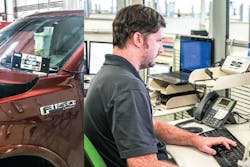ASTECH2
WEBSITE: astech2.com
COST: $2,500 for the device, $85 per scan
TRAINING: Virtually none
USES: Remotely diagnose vehicles
HOW IT WORKS:
As computer programs and lights on the dash became more of an issue in the collision repair industry over the last few years, the more issues he ran into at his business, the three-location B Street Collision Center in Omaha, Neb, says production manager Tony Wiese. For one, he says, purchasing aftermarket scan tools was expensive and required yearly updates. But secondly, he says the larger obstacle was training related.
“The biggest expense is always training the technician to be able to competently use it and be able to read the information it’s giving them so they know what to do,” he says. “Anybody can sit a guy behind a tool and pull codes but the actual diagnostic code time of getting on the computer, doing research to figure out what those codes mean and what the proper solving procedure is, is the problem.”
Wiese was looking for a way around that problem, which is why he decided to invest in the asTech2 remote diagnostic tool roughly a year ago. At an upfront cost of $2,500, it’s not only cheaper than one scan tool, but it also gives him access to nearly all makes and models 2008 and newer, allows him to find out what issue is causing the dashboard warning lights to stay lit, ensures all sensor systems are functioning properly, and identifies any hidden damage due to collision.
The way it works is simple: The technician connects the wireless, portable asTech2 unit to the vehicle’s OBD-II port and turns the ignition on. Then, he submits a service request (which is usually vehicle information, whether it’s a pre- or postrepair scan and the lights that are on) through the asTech website. Then, an OEM master technician at asTech’s headquarters will perform a full diagnosis of every vehicle module to resolve whatever problems might be occurring, generally within 30 minutes. During that time, the shop’s technicians do not have to be present and can work on other jobs.
“Having that skilled tech on the other end of the line is where the majority of the value lies,” he says. “It keeps my guys pulling dents and painting cars.”
Once the scan is complete, the shop will receive a full report, which includes an itemized printout of each module that needs to be addressed and the process that needs to be completed to fix that component.
“It’s a full written document that is proof of what the issues were on the car,” Wiese says. “It gives me all the information I need to justify what I did to the insurance company.”
THE RETURN:
Wiese says the asTech2 is one of the most useful tools in his shops for cutting cycle times. The benefits have been numerous. First, he no longer has to keep purchasing scan tools or calculate the ROI on those expensive tools. In addition, the asTech team works directly with OEMs to receive all updates that dealers do. That means that Wiese no longer has to worry about repair quality or comebacks due to inaccurate or incomplete information.
“The amount of time it takes to take a car to the dealer with two guys, go pick the car back up and have it sit there at the dealership, it might sit for a day or longer,” he says. “This creates significant help in decreasing that amount of time.”
Wiese estimates it took him roughly three months to recoup the cost of the tool. When it comes to the $85 cost per scan, he bills it out to his insurance companies. Wiese notes that it was a new concept for the insurers he works with, so before starting use of the tool, he met with his insurance partners and explained the value of it and how it would benefit them, as well. Wiese now rarely runs into trouble billing it out, but he does note that he needs to have a “justifiable reason” for the scan. That’s why he doesn’t scan every single vehicle, although he says he hopes to progressively start using it more and eventually scan more vehicles.
“If it’s a $700 bumper job, it’s highly unlikely you’ll have a code,” Wiese says. “There’s not a justifiable reason.”
